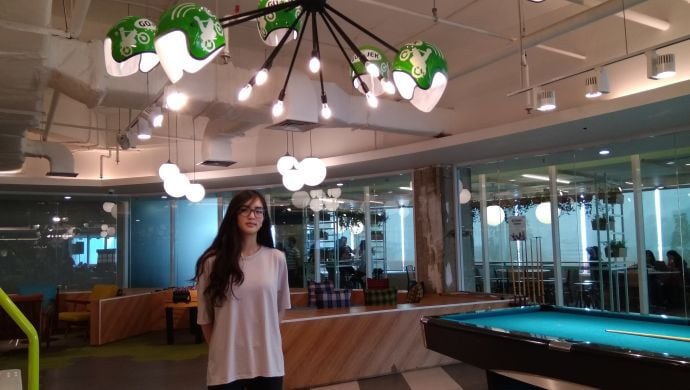When it comes to the use of data, Crystal Widjaja, Go-Jek SVP of Business Intelligence, says that the opportunities to grow are abundant

Go-Jek Indonesia SVP, Business Intelligence Crystal Widjaja at the company’s HQ in South Jakarta
Do you know that, on average, Go-Jek drivers have travelled more than 4,500 km delivering orders during their lifetime? For context, that is a distance about twice the size of the Java island perimeter.
The ride-hailing unicorn’s food delivery service Go-Food has also delivered more than 3 million martabaks (stuffed pancake) in the past year in its home market of Indonesia.
During the month of Ramadan, the company can even tell you the most popular mosques in Jakarta that customers have visited.
Looking at the wealth of data that the services produce each day, it is natural to be curious about how the company is utilising this resource.
e27 spoke with Go-Jek SVP of Business Intelligence, Crystal Widjaja, to get an idea of how they do it.
“The business intelligence (BI) team is not only for developers and BI analysts, but also for the entire company. We utilise BI for every product, corporate finance, accounting, legal, and customer care,” she explains.
The team takes data from the back-end of every service that Go-Jek offers, from ride-hailing service Go-Ride to the ticket booking platform Go-Tix. They clean and humanise the data from the back-end, and turn it into information such as ‘booking conversion rate’.
The priority is to make the data as understandable as possible, which the BI team used to build a self-service platform that the management team can use to access data easily for making decisions.
Also Read: Go-Jek acquires Loket to further dominate event management and ticketing space in Indonesia
“A lot of what we do is really on the optimisation and prioritisation of features within a product, areas that require more developments, or pain points … So a lot of data that we will use is geo-locational data. Every area in the city, we can see how it is performing,” Widjaja says.
“We determine different matrixes like how many drivers pass through this area, how many customers book in this area, what is the conversion rate look like, is the demand being met with good supply? So by looking at it we can identify key areas that are constantly under-performing, or things like areas where there is a lot of Go-Food demand but not enough merchants to fulfil the type of food that they are looking for,” she continues.
The company has even opened an office in Singapore that is focussed on data science.
Widjaja also revealed that Go-Jek has also been providing a digital dashboard for Indonesia’s ministry of transportation.
“To be heavily involved in how they government is able to improve the life of the Indonesian citizens is something that we are very interested in, and we are open to future projects like that,” she says.
Challenges and opportunities
Go-Jek has been collecting data for about two years. Even then Widjaja saw that the opportunities to grow was abundant.
“In the grand scheme of things, we actually don’t have that much data from a timeline perspective. But the growth that we are seeing is like 30 per cent in just the data points that we are collecting on a monthly basis,” she says.
“That kind of shows that we are going to have a lot more opportunities to look at these big data and find hidden opportunities that maybe most people wouldn’t be able to see, like on a weekly or daily basis,” she continues.
Also Read: Go-Jek to enable Go-Pay transaction with merchants partners outside of its ecosystem
Widjaja gave an example of how the company was able to determine the most difficult areas in the city to travel through, based on the trend of common routes over the past two years. Using that knowledge, Go-Jek was able to push for marketing for Go-Ride service in that particular area.
“The opportunity here for big data for most companies would be to think more of the long term; What would be the problems that we can solve one day if we just collect all those different data points and storing it at one place?” she says.
The lesson
So what are the key lessons that Widjaja has learned in the two years implementing data for Go-Jek?
“Don’t be so overly focussed to track and analyse every single data point. There are some obvious key input matrices that have been a real game-changer for us in terms of our output matrices, which is booking conversion rates, and for us to be very focussed on input matrices,” she explains.
Widjaja then gives an example of when the team wants to find out about whether the loading time of the web page will affect customers’ booking completion rate.
“That input matrix becomes, ‘What is the loading time of our web page?’ For us, we’re very focussed on understanding whether or not the input matrix that we hypothesised are directly correlated with those output matrix to figure out what really matters. But we do it one at a time in an experimental form, so we always do A/B tests,” she says.
“We always have to start with that hypothesis. What is the matrix that I am going to focus on?” she adds.
For those who are new in this field of work, her advice would be to focus on the hypothesis and the goal itself.
“Every piece is analysis shouldn’t be done for fun, although analysis is super fun,” she closes.
—-
The post Delivering 3M martabaks in a year: How Go-Jek uses big data to run business better appeared first on e27.